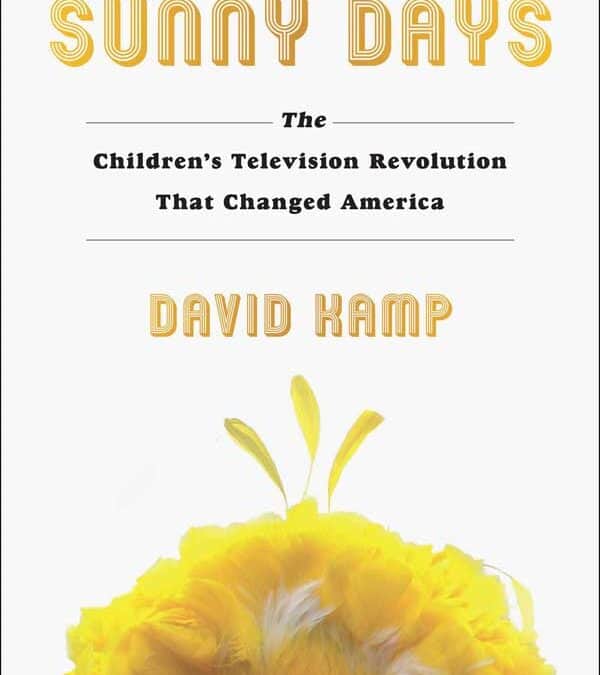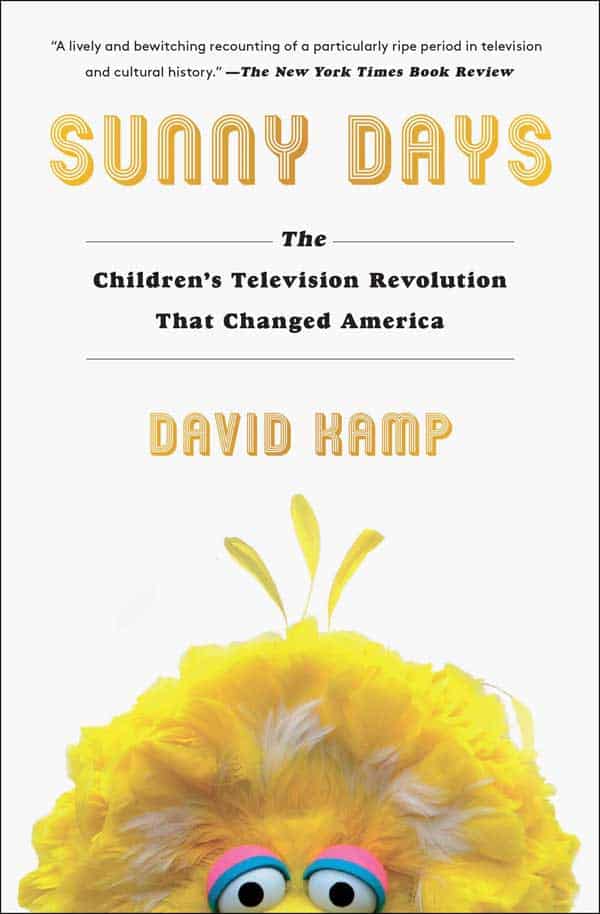Sunny Days, The Children’s Television Revolution That Changed America by David Kamp
Recommendation
David Kamp’s nostalgic, thought-provoking romp through 1970s kids’ TV programs will remind you that American television once served the public good. Creators such as Joan Ganz Cooney, Jim Henson, Fred Rogers and David McCall channeled their 1970s activism into TV shows that sought to enlighten, entertain, motivate and educate young children. Sesame Street shifted paradigms by emphasizing diversity and exposing inequality. The Electric Company, Zoom, Free to Be…You and Me and Schoolhouse Rock! reflect the era’s exuberance, audacity and belief that children are the future.
Take-Aways
- In the 1950s and 60s, television transformed America – and not always in good ways.
- Fred Rogers’ Mr. Rogers’ Neighborhood brought out children’s feelings and explained society’s problems.
- Sesame Street’s creators were diverse, idealistic geniuses who researched and improvised their way to breaking old paradigms.
- Inner-city, multi-racial kids finally saw themselves and their neighborhoods on TV.
- The Children’s Television Workshop (CTW) fomented debate among Black intellectuals about racism.
- Schoolhouse Rock! originated with a successful adman from New York.
- CTW created The Electric Company for seven-to-nine-year-olds who needed remedial reading help, but the show reached beyond that demographic.
- Today’s best children’s television shows owe their educational heritage to 1970s idealism.
Sunny Days Book Summary
In the 1950s and 60s, television transformed America – and not always in good ways.
In 1946, only about 8,000 people in the United States had televisions. By 1961, 47 million people or 90% of all American homes had TVs. Adults watched an average of six hours a day; kids spent more time watching television than they did in school.
Half the schools in the United States didn’t offer kindergarten classes. Middle-class white households had resources to educate kids at home, but Black and Latino kids from poor neighborhoods were falling behind. The nation faced an equity and educational gap.
“Is there no room on television to teach, to inform, to uplift, to stretch, to enlarge the capacities of our children? – Newton Minow, to the FCC in 1961.”
In 1964 , Lyndon Johnson signed the Elementary and Secondary Education Act, which distributed funds to high-needs districts of low-income families. Combined with advances in cognitive psychology and early-childhood development, the legislation allowed for experimentation in education. Nothing significant appeared until Fred Rogers’ and Joan Ganz Cooney’s pioneering shows, Mr Rogers’ Neighborhood and Sesame Street launched a Big Bang in programming for children, shaping the culture for decades to come.
Fred Rogers’ Mr. Rogers’ Neighborhood brought out children’s feelings and explained society’s problems.
Rogers hosted a CBC kids’ show in Canada and earned ordination as a Presbyterian minister; by 1968, he was seasoned and ready for a more ambitious project. His Mister Rogers’ Neighborhood would introduce kids to real-life events, such as getting a haircut, with their “friend” Mr. Rogers. The show became enormously popular. The US Public Broadcasting System (PBS) and other funders underwrote it and, soon, millions of kids could see Mr. Rogers on public television. His calm demeanor and intellectualism increased his appeal to small children.
“I am anxious to make a lasting contribution to the field of children’s television.”
Rogers didn’t balk at difficult subject matter. In 1969, the show aired an episode in which Rogers and a Black police officer character cooled their feet in a kiddie swimming pool, an audacious show of solidarity with the Civil Rights movement. Rogers recorded 455 episodes, in color, for PBS. His life’s work remains available to each new generation of young children.
Sesame Street’s creators were diverse, idealistic geniuses who researched and improvised their way to breaking old paradigms.
Joan Ganz Cooney believed in kids’ television programming that taught children “how to think, not what to think.” She had a deep respect for how kids learn and engage. Through her personal connections in New York, she produced a feasibility study on early-childhood education for the Carnegie Corporation. In 1967, she received grants from Carnegie, the Ford Foundation and the US Office of Education to create an educational children’s TV program. She became the Executive Director of the new Children’s Television Workshop (CTW).
“Henson was innately an agent of imaginative thought, and, to boot, a born teacher and mentor: ideal qualities for a children’s television program.”
Cooney’s vision of bringing educational programs to a specific demographic – inner-city, low-income children of color – inspired four men who collaborated with her. Jon Stone became main concept head. He hired Joe Raposo to write music and brought the gifted Jim Henson onboard for puppeteering. Dave Connell oversaw animation; Sam Gibbon was curriculum supervisor and Matt Robinson, the only Black member of the production team, produced the live-action sequences. Cooney had her team of “bona fide geniuses.”
Cooney made a brilliant decision: Instead of hiring teachers to turn into TV personalities, she found entertainers to turn into teachers. Henson understood instinctually what educators knew intellectually, and his Muppets embodied that spirit.
Inner-city, multi-racial kids finally saw themselves and their neighborhoods on TV.
Sesame Street first aired in November 1969; it was an overnight smash hit, reaching seven million households. The show’s number one target was inner-city three and four-year-olds, mostly Black and Hispanic, left behind by institutional neglect and white flight to the suburbs. In places like Harlem in New York, people participated in an active street life, and the front steps – the stoop – of brownstone apartment buildings were integral to the vibe. Jon Stone wanted this feel for Sesame Street.
“I was determined,” Stone said, “that our neighborhood present a positive image of interracial harmony and a community united through its pride and sense of responsibility.”
Some inner-city kids lacked televisions, so they couldn’t watch Sesame Street. Evelyn Payne Davis, a New York activist for African-American communities, led an outreach effort to raise money for Sesame Street centers in churches, libraries and rec centers. She recruited not-for-profits to distribute promotional materials door to door. Her efforts resembled the work of a social-services agency more than an advertising department, as she coordinated with 12 cities with marginalized populations. With Sesame Street’s diverse cast, which included Black and Hispanic characters, inner-city children finally had the empowering experience of seeing people on television who lived on a familiar street and understood their unique lives.
The Children’s Television Workshop (CTW) fomented debate among Black intellectuals about racism.
The creative people at the Children’s Television Workshop were doing something new and daring: conducting a social experiment on children’s development. This created controversy. Some southern politicians considered banning Sesame Street because it showed racial integration. A New York Magazine “hit piece” in April of 1971 by Linda Francke, a white author, argued that Black people didn’t like the show or found it detrimental to kids. She accused the CTW of competing with Head Start, the federal program to aid young children.
“It helped create a new normal in which Black culture was not a marginalized subculture but a fundamental part of mainstream American life.”
More controversial still was a new character on the show, a purple Muppet named Roosevelt Franklin created by Matt Robinson, who believed the show needed more “realism” about problems in Black communities. Roosevelt spoke in Black vernacular, and within a couple of years, his popularity led to a 12-track R&B record album. Some Black activists found Roosevelt “one-dimensional.” They felt if Sesame Street wanted to portray Black characters, it should show a spectrum. The CTW dropped Roosevelt in 1977. The show remained multicultural, with Spanish language segments and visits from Buffy St. Marie, an indigenous musician.
Schoolhouse Rock! originated with a successful adman from New York.
Sesame Street proved paradigm-shifting, challenging outdated ideas about race and status. Other shows, while never matching Sesame Street’s popularity, benefited from its example.
Following the example of PBS, other networks agreed to abide by new policies mandating that children’s programs would refrain from in-show product pitches and forbidding ads for vitamins or medications. Some offered meaningful engagement, such as ABC’s Afterschool Specials.
“Schoolhouse Rock!, whose original run carried it into the early 1980s, was as acclaimed by adults as it was loved by kids.”
In a strange twist, one of the most entertaining educational programs on network television came not from educators, but from David McCall, a successful adman and activist. Determined to use his skills to help kids learn math, he recruited talented people to write multiplication songs for a record album. When he heard Bob Dorough’s “Three is a Magic Number,” he knew he had to move the project to television. With buy-in from ABC executive Michael Eisner, Multiplication Rock debuted in 1973 and became instantly popular. It expanded into grammar and American history. The Schoolhouse Rock! roster includes such iconic pieces as “Figure Eight,” “Conjunction Junction” and “I’m Just a Bill.”
CTW created The Electric Company for seven-to-nine-year-olds who needed remedial reading help, but the show reached beyond that demographic.
When the CTW took on the challenge of helping seven-to-nine-year-olds read, they knew they needed a different approach than they employed on Sesame Street. Humor and a faster pace would work better with older kids. The Electric Company’s creators found their inspiration in sketch comedy and – given Sesame Street’s pedigree – they attracted Morgan Freeman, Joan Rivers, Gene Wilder, Zero Mostel, Mel Brooks and Rita Moreno.
“To this day, no TV program has been more widely used in US classrooms than The Electric Company was in its Seventies heyday.”
Like its sister program, The Electric Company (1971-77) had a diverse cast, including its all-kid rock band, “Short Circus.” The show presented its diverse cast members as people, not as Hispanics, Blacks or Caucasians. The aesthetic featured rock music, funky graphics and casual speech. It keyed into kids’ penchant for chaos, aided and abetted by a gorilla character. Two million kids tuned in after school. The Electric Company remains a staple for in-class instruction. It reached far beyond its original remedial learners to kids of all ages and levels, and to adults learning English.
Today’s best children’s shows owe their educational heritage to 1970s idealism.
The 1980s witnessed a gradual decline in quality children’s programming.The CTW never replicated the ingenuity of Sesame Street and The Electric Company. Over time, problems arose with funding and support from the US government. Ronald Reagan appointed an FCC chief who scoffed at the utility of television as a vehicle for public interests. With commercialism predominant, TV shows based on toys proliferated: My Little Pony, Teenage Mutant Ninja Turtles and The Transformers among them. Kids’ TV fell back into gendered marketing, rolling back the 1970s’ progressiveness.
“Consider HBO’s incentive to invest in Sesame Street…the program is still, after all these years, the gold standard of what children’s television is capable of.”
The 1990s and early 2000s ushered in better children’s shows, such as Blue’s Clues, Dora the Explorer and Bear in the Big Blue House, a Jim Henson production. Gen Xers who grew up with Sesame Street and Schoolhouse Rock! encouraged reboots, reinvigorating those programs with mixed results. Sesame Street fell into commercialism, becoming more “cutie-pie” with the new puppet Elmo, designed to attract younger viewers than the original four-to-seven-year-old demographic.
Facing mounting production costs and losses, the Children’s Television Workshop (now named the Sesame Workshop) accepted assistance from HBO in 2014. This was not ideal for its brand: HBO is a paid, premium cable channel that the poorest Americans cannot afford. Sesame Workshop’s alliance with HBO appeared to run counter to the program’s original purpose: to close the gap between rich and poor, Black and Caucasian, inner-city and suburban children.
About the Author

Author of The United States of Arugula, David Kamp is a charter member of the Sesame Street audience. His writing has appeared in Vanity Fair, GQ and The New York Times.


